|
Sulfur (S) deficiency may not be recognised easily in the field, as the symptoms are
not obvious except in severely deficient plants. However, recent soil fertility
studies have shown that sweetpotato production may be frequently limited by low
sulfur supply. Deficiencies have been documented on ultisols from the Papua New
Guinea Highlands, andesitic volcanic ash soils in Tonga and coralline soils from
coastal Papua New Guinea.
On the other hand, it appears that
sweetpotato may be more tolerant of low sulfur than are a number of other crops.
Sulfur deficiency is much more frequently reported in legume, cereal and tree
crops than in sweetpotato. On low-sulfur soils of the North Guadalcanal Plains
in the Solomon Islands, it was noted that, although a number of pasture grass,
legume and tree species responded to sulfur fertiliser, sweetpotato did not.
Sulfur (dissolved as sulfate) is readily
leached from the soil, and weathered soils in high rainfall areas frequently
have a low sulfur status. Burning of vegetation results in gaseous losses of
sulfur (as SO2) from the farming system. Regular high levels of phosphorus
application may displace sulfur from the soil matrix and contribute to sulfur
depletion. In areas close to industrial or volcanic activity, rain will take
sulfur from the air and may provide sufficient sulfur to maintain crop
production. Sea spray may also be a significant source of sulfur in coastal
areas, but sulfur deficiency has been reported even on small islands.
Sulfur deficiency results in a uniform
pale green chlorosis throughout the plant. Veins do not retain a green colour, and in many cases, they may be even paler than the interveinal tissue. In cultivars in which young leaves are normally green (ie.
lacking red pigmentation), the youngest leaves may appear pale earlier or more
severely than mature leaves. This is not obvious in cultivars with red or purple
tips.
A considerable reduction in growth may be
suffered without the appearance of any visible symptoms. Clear symptoms are
associated with severe stunting,
accompanied by reduced leaf size, and reduced activity of axillary
buds, resulting in less branching.
Purple or red-brown pigmentation may
develop on both young and old leaves. In cultivars with normally green shoot
tips, the petiole and margins of young leaves may become red, and this may
extend in a mottled pattern over interveinal areas of the upper leaf surface. A similar pattern is seen on the oldest leaves, although it is often
confined to the tips of lobes rather than extending around the entire margin.
Leaves of intermediate age generally lack purple pigmentation. In plants which
normally have purple-pigmented shoot tips, pigment is lost in the normal manner
as leaves mature (in contrast with nitrogen deficiency).
The general growth reduction and
yellowing of the whole plant closely resemble the symptoms of nitrogen
deficiency. A useful distinguishing character is the red pigmentation of
veins of young leaves in nitrogen-deficient plants, but no pigmentation on the
oldest leaves. While sulfur deficiency may increase pigmentation of young leaf
margins and petiole, a strong veinal pattern is not typical, and the oldest
leaves are usually also pigmented.
When no purple pigmentation is present,
the problem may be solved using fertiliser test strips. Two fertilisers, sulfate
of ammonium (a fertiliser containing both sulfur and nitrogen), and urea (which
contains only nitrogen) are applied to one row each of sweetpotato plants, with
an untreated row between. After a week or two, if plants green up with sulfate
of ammonium, but not with urea, it is likely that they were suffering from
sulfur deficiency; if both treatments are equally effective, the problem is
probably nitrogen deficiency.
A critical concentration of 0.34% S in
the 7th to 9th youngest leaf blades was estimated in
solution culture studies using the cv. Wanmun. In healthy plants, concentrations
were generally between 0.35 and 0.45% S.
The chemistry of sulfur in soils is
complex and there is no reliable measure of plant-available sulfur which can be
applied over a wide range of soil conditions. Total sulfur measurements may be
related to crop response to sulfur fertiliser only when the soil sulfur reserves
are very low. Calcium phosphate extraction is used to estimate the soluble plus
adsorbed sulfate fraction (Rayment and Higginson, 1992). This may be used to
predict sulfur deficiency in soils with a low organic matter content, but in
most humid tropical soils, sulfur is predominantly supplied from the degradation
of organic material. Approximate critical levels are 200 mg/kg total S, or 6 -
12 mg/kg extractable S, below which S deficiency is likely in soils with a low
organic matter content.
In the field, the most practical way of
confirming a suspected sulfur deficiency may be to apply a sulfur-containing
fertiliser to a small area, and observe the response over the following 1-2
weeks.
Cultural control
Sulfur deficiency is usually corrected by
the addition of a sulfur-containing fertiliser. The fertiliser chosen may be
primarily for supplying S, such as gypsum or elemental sulfur, or sulfur may be
added as a constituent of fertilisers intended to supply other nutrients, such
as ammonium sulfate (24% S, but also contains nitrogen) or single superphosphate
(11% S, but also contains phosphorus). It should be noted that many “high-analysis”
fertilisers such as triple superphosphate, monoammonium phosphate, diammonium
phosphate and urea, contain only trace amounts of S.
The maintenance of a high organic matter
content in the soil will also increase the availability of sulfur to the roots,
and decrease the rate of nutrient leaching. Burning of crop and fallow residues
leads to direct losses of sulfur to the atmosphere, and loss of organic matter
inputs to the soil. This practice not recommended where sulfur supply is poor.
Chase, L.D.C. and Widdowson, J.P. 1983. Sulfur in the agriculture of Pacific High
Islands. In: Blair, G.J. and Till, A.R. (eds.) Sulfur in South East Asian and
South Pacific agriculture. Commonwealth of Australia. pp 206-217.
Dowling, A.J., Konabe, B. and Tigat, R. 1994. Nutritional
assessment of steeply sloping soils from Aiyura in the Eastern Highlands of
Papua New Guinea. Papua New Guinea Journal of Agriculture, Forestry and
Fisheries, 37(2), 23-29.
Fox, R.L., Asghar, M. and Cable, W.J. 1983. Sulfate
accretions in soils of the tropics. In: Blair, G.J. and Till, A.R. (eds.) Sulfur
in South East Asian and South Pacific agriculture. Commonwealth of Australia. pp
39-53.
Halavatau, S., Asher, C.J. and Bell, L.C. 1996. Soil
fertility and sweet potato research in Tonga - Nitrogen and Phosphorus. In:
Craswell, E.T. Asher, C.J. and O’Sullivan, J.N. (eds.) ACIAR Proceedings
No.65: Mineral nutrient disorders of root crops in the Pacific. pp 58-64.
Landon, R.J. 1991) (ed.) Booker tropical soil manual: a
handbook for soil survey and agricultural land evaluation in the tropics and
subtropics. Booker Tate Ltd; Longman, London.
O’Sullivan, J.N., Asher, C.J. and Blamey, F.P.C. 1997.
Nutrient Disorders of Sweet Potato. ACIAR Monograph No. 48, Australian Centre
for International Agricultural Research, Canberra, 136 p.
Rayment, G.E. and Higginson, F.R. 1992. Australian laboratory
handbook of soil and water chemical methods. Inkata Press, Australia.
Vance, P.N., George, S. and Wohuinangu, J. 1983. Sulfur in
the agriculture of Papua New Guinea. In: Blair, G.J. and Till, A.R. (eds.)
Sulfur in South East Asian and South Pacific agriculture. Commonwealth of
Australia. pp 180-190.
Contributed by:
Jane O'Sullivan
|
Characteristics
and occurrence
Symptoms
Confusion
with other symptoms
Diagnostic
tests
Management
References
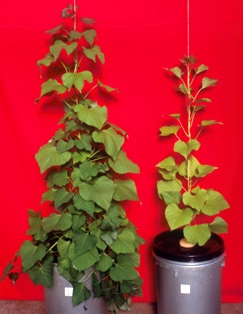
Reduction in growth, branching and leaf
size and general paling of leaves on S-deficient plant (right) (J. O'Sullivan).
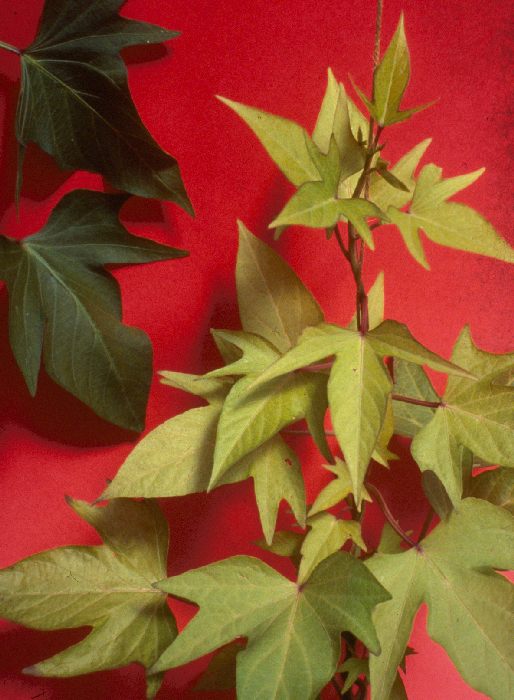
Light green chlorosis affects the whole plant, but
in some varieties young leaves may be palest (J. O'Sullivan).
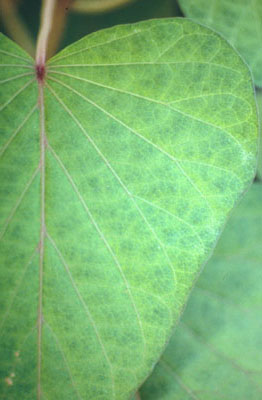
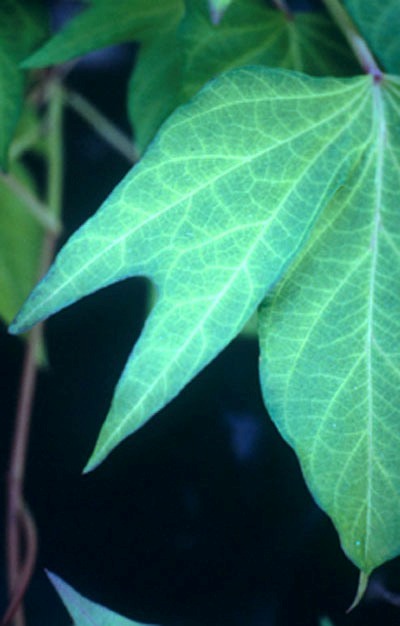
Chlorosis on and adjacent to veins of mature leaves, varying with variety
(J.
O'Sullivan).
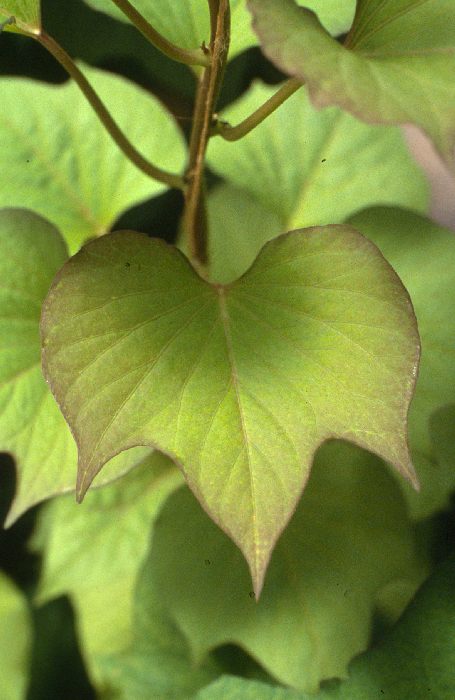

Purpling of margins and interveinal areas is
common on both young and oldest leaves (J. O'Sullivan). |

